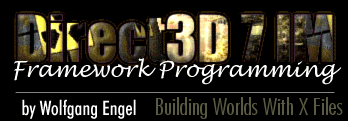11/10 - 11/12 @ Montréal, Canada
12/5 - 12/7 @ Shanghai, China
12/24 - 12/27
2/28 - 3/4 @ San Francisco, CA
More events...
2406 articles in the reference section.
Help us fight cancer!
Join SETI Team GDNet!

|
Preface
To make a game, programmers and graphic designers need to work closely together. 3D characters, models and 3D worlds are build and animated in specialized 3D programs, such as 3D Studio MAX, Maya, Lightwave, trueSpace and so on. After building the graphics with such tools, they have to be imported into the game engine. So if you'd like to be a game programmer, you need to understand how to load a 3D model or world file generated by external tools into your game engine. As a sample application, I've modified the sample of the second tutorial First Steps to Animations. So you know most of the source and you can concentrate on the new X file code. To compile the sample program, you have to link with an additional file: d3dxof.lib. It's used by the Framework D3DFile class. If you'd like to know more on compilation of these tutorials, try to take a look in the first Direct3D.net tutorial "The Basics.
|
||||||||||||||||||||
|
|
||||||||||||||||||||